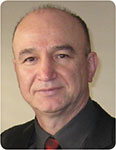Lithofacies and sequence stratigraphic framework of the Kockatea Shale, Dandaragan Trough, Perth Basin
Hanieh Jafary Dargahi A and Reza Rezaee ADepartment of Petroleum Engineering, Curtin University
The APPEA Journal 53(1) 1-8 https://doi.org/10.1071/AJ12001
Published: 2013
Abstract
Initial studies affirm large-scale shale-gas potential for the Permo-Triassic intervals of the Perth Basin. The Dandaragan Trough, as a major depocentre in the basin and with the highest number of wells intersecting these intervals, has possibly the greatest shale-gas potential in the area. The primary self-contained shale-gas system proposed for the Dandaragan Trough is in the basal Kockatea Shale (Hovea Member), which was deposited during the Late Permian-Early Triassic.
Seven lithofacies have been identified in a continuous 35 m core from the Hovea Member of the Kockatea Shale at Redback–2. Among recognised lithofacies, besides siliceous mudstone, which contains clastic particles, most are representative of deposition in a shallow marine environment with different energy levels. Bioturbated lithofacies reveal deposition in a higher-energy environment compared with the other lithofacies.
The sequence stratigraphic framework of the Hovea Member is established based on diagnosis of the lithofacies, cyclical stacking patterns, transgressive surfaces of erosion (TSE), and condensed sections (CSs). The framework supports deposition mainly in an aqueous environment with rare regressions. Periodic tectonic activity can be revealed in high-frequency relative sea-level changes during Hovea Member deposition. Gamma ray (GR) log analysis indicates that the highest GR peak is related to black-shale lithofacies with 1.75% TOC content.
The greatest amounts of TOC, however, exist in the fossiliferous mudstone and pyritic mudstone lithofacies. A north–south GR correlation of the Hovea Member shows nearly the same lithological distribution throughout the trough despite its thinning in various areas.

Hanieh Jafary Dargahi is a PhD candidate in Curtin University’s Department of Petroleum Engineering. She is working on identifying the shale-gas potential of the Perth Basin in cooperation with the shale-gas research group. Hanieh’s areas of interest are geology, petrography, sequence stratigraphy, and organic geochemistry. She has published four journal papers and one peer-reviewed conference presentation. Presently, Hanieh is studying under the supervision of Associate Professor Reza Rezaee in Curtin University’s shale-gas research group. hanieh.jafarydargahi@postgrad.curtin.edu.au |

Reza Rezaee of Curtin University's Department of Petroleum Engineering has a PhD (reservoir characterisation). He has more than 25 years of experience in academia. He has supervised more than 60 MSc and PhD students during his university career to date. He has published more than 120 peer-reviewed journal and conference papers and is the author of three books about petroleum geology, logging, and log interpretation. His research has been focused on integrated solutions for reservoir characterisation, formation evaluation, and petrophysics. Presently, he is focused on unconventional gas, including gas shale and tight gas sand studies. He is lead scientist for the WA: ERA (EIS) tight gas and shale gas research projects. He established Curtin University's unconventional gas research group in 2010. R.Rezaee@exchange.curtin.edu.au |


